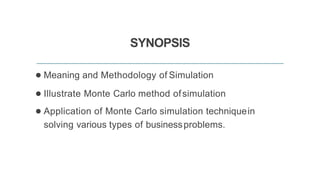Simulation technique in OR
- 1. SIMULATION
- 2. SYNOPSIS â Meaning and Methodology of Simulation â Illustrate Monte Carlo method ofsimulation â Application of Monte Carlo simulation techniquein solving various types of businessproblems.
- 3. SIMULATION â Simulation is the process of designing a model of a real system and then performing experiments on the model (rather than on the real system itself) for the purpose of understanding the behaviour for the Operation of the system. â It is a duplication of theoriginal System â It can be used for a wide variety of practical problems. â The simulation approach is relatively easy to explain and understand. As a result, management conïŽdence is increased and acceptance ismore easily obtained.
- 4. Application â Inventory Control â Financial studies involving risky investments â Examining a series of marketing policies to ïŽnd the best product mix, price, promotion levels, Advertising allocation. â Analysing where to locate factories and warehouses in order to distribute goods at the minimum cost .
- 5. Methodology for Simulation â DeïŽne ( Identify ) the problem â Identify Decision variables â Develop or Construct Simulation Model â Validate the model â Specify values of decision variables to betested â Run or Conduct the simulation â Examine the results and implement theïŽndings
- 6. Monte Carlo Simulation It is an Experiment on Chance. The Monte â Carlo technique uses random number and is generally used to solve problems requiring decision-making under uncertainty and where mathematical formulation is impossible.
- 7. Understanding of Monte Carlo Simulation Technique â 1. Establishing Probability Distribution â 2. Cumulative Probability Distribution â 3. Setting Random Number Intervals â 4. Generating Random Numbers â 5. To ïŽnd the answer of question asked using the above 4 steps.
- 8. Simulation of an Inventory System Example: A bakery keeps a stock of a popular brand of cake. Previous experience shows the daily demand pattern for the item with associated probabilities , as given below: Daily demand 0 10 20 30 40 50 Probability 0.01 0.20 0.15 0.50 0.12 0.02
- 9. ContdâĶ â Use the following random numbers to simulate the demand for next 10 days. Random numbers:48, 78, 19,51,56,77,15,14,68,9 Estimate the daily average demand for the cakes on the basis of simulated data.
- 10. Determination of Random Number Interval Demand Probability Cumulativ e Probability Random Number Interval 0 0.01 0.01 00 10 0.20 0.21 01-20 20 0.15 0.36 21-35 30 0.50 0.86 36-85 40 0.12 0.98 86-97 50 0.02 1.00 98-99
- 11. Simulation Experiment Worksheet Day Random Number Demand 1 48 30 2 78 30 3 19 10 4 51 30 5 56 30 6 77 30 7 15 10 8 14 10 9 68 30 10 09 10
- 12. Simulation â Expected Demand on the basis of the simulated data, =220/10 = 22 cakes/day
- 13. Simulation Demand/week 0 5 10 15 20 25 Frequency 2 11 8 21 5 3
- 15. Determination of Random Number Interval Demand Probability Cumulativ e Probability Random Number Intervals 0 2/50=0.04 0.04 00-03 5 11/50=0.22 0.26 04-25 10 8/50=0.16 0.42 26-41 15 21/50=0.42 0.84 42-83 20 5/50=0.10 0.94 84-93 25 3/50=0.06 1.00 94-99
- 16. Simulation Experiment Worksheet Week Random Number Demand 1 35 10 2 52 15 3 90 20 4 13 5 5 23 5 6 73 15 7 34 10 8 57 15 9 83 15 10 95 25
- 17. Example on Production Line Production line turns out about 50 truck per day, ïŽuctuations occur for many reasons. The production can be described by a probability distribution as follows: ( attached in Excel). Finished trucks are transported by train at the end of the day. If the train capacity is only 51,what will be average number of trucks waiting to be shipped and what will be the average number of empty spaces on the train? Use the given sequence of random numbers to simulate the production for next 8 days.
- 18. SIMULATION OF QUEING SYSTEM Dr. Kumar is a dentist who schedules all her patients for 30 minutes appointments. Some of the patients take more or less than 30 minutes depending on the type of dental work to be done. The following table shows the various categories of work, their probabilities and the time actually needed to complete the work:
- 19. SIMULATION Category of Service Time required ( minutes) Probability Filling 45 0.40 Crown 60 0.15 Cleaning 15 0.15 Extraction 45 0.10 Check-up 15 0.20
- 20. SIMULATION Simulate the dentistâs clinic for four hours and determine the average waiting time for the patients as well as the idleness of the doctor. Assume that all the patients show up at the clinic at exactly their scheduled arrival time starting at 8.00 am. Use the following random numbers for handling the above problem: 40 82 11 34 25 66 17 79
- 21. SIMULATION At a service station a study was made over a period of 50 days to determine both the number of automobiles being brought in for service and the number of automobiles serviced. The results are given in the excel table. Simulate the arrival service pattern for a ten-day period and estimate the mean number of automobiles that remain in service for more than a day. Use the following random numbers For arrival s 09 54 42 01 80 06 06 26 57 79 For Servic e 49 16 36 76 68 91 97 85 56 84





















